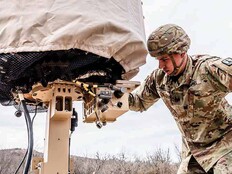What Is Robotic Process Automation?
RPA is commercial automation software that mimics the way a human would complete a task, notes Maureen Fleming, program vice president for integration and process automation at IDC. “Each task is broken down into the steps required to perform the work manually,” she says. “Then different types of automation techniques are applied to each step and chained together into a flow. On playback, each step emulates the human step until the task is completed.”
Sometimes, not every task can be automated, Fleming says. In that instance, the RPA software “runs the automation but pauses for human feedback, then continues running,” she adds
Robert Zebroski, program manager for RPA in the Defense Logistics Agency’s Information Operations department, says that because RPA software mimics human actions to accomplish computer-based activities, it enables “employees to spend more time on higher-value tasks.”
DLA, which provides logistical support to the military, uses RPA to more efficiently respond to Freedom of Information Act requests, in finance and other aspects of its operations.
“At DLA, we define it as an important technology that automates manual, repetitive tasks, returning valuable time to our knowledge workers while speeding up supply chain management practices and furthering our culture of innovation,” he says.
MORE FROM FEDTECH: What should agencies consider before deploying AI?
How to Implement Robotic Process Automation
There are several foundational technology elements needed to make RPA run efficiently and effectively.
Most organizations adopt commercial RPA platforms for task automation, Fleming says. Before the advent of RPA, when a task needed to be automated, software developers would have had to “custom-code the automation or build embedded macros in things like Microsoft Word or Excel,” Fleming says.
“RPA generates the automation in a builder, or studio environment, then initiates the automation through a variety of mechanisms that move the code to a software robot, where it performs the task,” she says. “In essence, the code is built in the platform studio. In production, that code is called up and interpreted and run by a software robot.”
Robotic desktop automation is software that can run on an end user’s computer, Fleming says. Notably, all RPA platforms run in a data center environment, and some RPA platforms run in a public cloud, Fleming says. These cloud-based RPA tools are increasingly packaged as a service, and RPA vendors operate commercial Software as a Service services for RPA. Other vendors provide a hosted private cloud model.
“Automation Anywhere can extend to a hybrid configuration that centrally manages software robots. Those robots can run in the cloud, as agents on end-user computers, and on servers running in enterprise data centers,” Fleming says.
DLA is using RPA technology to more efficiently respond to Freedom of Information Act requests.
This model allows agencies “to gain benefits from a SaaS operating model while also running some of the software robots privately in the data center,” Fleming says. That offers a “balance of doing work that is confidential and protected by nature while also running other robots securely in the cloud,” she says, adding that IDC expects to see more vendors move to this type of model.
GSA CFO Gerard Badorrek says there is a relatively low barrier to entry for adopting RPA, and that agencies can get started with an RPA pilot by simply installing RPA software on their desktops or in a virtual environment.
“The technology is relatively easy to learn, and the coding is intuitive. It is fairly easy to build a few automation pilots that demonstrate the potential of RPA,” he says.
However, to build a robust program, Badorrek says “agencies need to fit RPA within their existing technology infrastructure and requirements,” which requires “partnering with the IT organization and other relevant stakeholders to ensure the software is approved, ensure the authority to operate is achieved, obtain necessary approvals for individual automations (security, privacy and credentialing) and deploy an enterprise RPA platform.”
At DLA, the agency’s initiative to modernize and centralize its applications and platforms allowed it “to implement and grow its RPA program successfully,” Zebroski says.
“As most of our agency applications were accessible via web portals, intranet or internet, it helped make our RPA journey a lot more efficient and smoother,” he says. “Accessing those applications in the same method as a DLA user would, which we were able to do for the DLA RPA bots by creating them as a non-person entity, was one of the key drivers for our success.”
Zebroski says that “achieving this would not have been possible without a solid security component such as a hardware security module. As the DLA’s bots needed to navigate the government landscapes and applications, which use certificate-based authentication, an HSM allowed us to securely store the required private keys for our bot software certificates, which were then used to navigate our applications.”
The DLA has also focused on “scaling efficiently and in a cost-effective manner, which has been possible due to DLA’s pursuit of a cloud-based deployment.”
VIDEO: What are the seldomly asked questions around emerging tech?
The Benefits of RPA in Government
The use cases for government parallel use cases in business, Fleming notes.
Those use cases include automated Excel-based consolidations, websites to capture changes to data, automated address changes across all government systems requiring the new address, automated filling out of forms and applications, registration processing, claims processing, preparing data, automated ordering, order processing and performing financial validations.
All of those RPA uses speed up work and reduce errors, according to Fleming.
“Task automation projects typically center on benefits that speed up process cycle times by performing more work faster. They reduce errors by replacing manual data entry, they avoid the need for new hires and they stand in when volumes are irregular — for example, in spikey periods tied to different time periods,” Fleming says.
In business, the holiday shopping season causes spikes in activity. For government, the same can be said for tax season for the IRS, or the decennial count for the Census Bureau.
“With RPA, you don’t have to hire as many people during the seasonal peaks,” Fleming says. “So, you get quality, speed, lower seasonal labor costs, more frequent validation work that was previously ignored because of labor costs, etc.”?
GSA has incorporated RPA into critical finance, human resources, IT, procurement and administrative processes, according to Badorrek, and has 58 automations deployed that create over 150,000 hours of annualized workforce capacity. GSA has a pipeline of 25 automations in development that are “aimed at solving agencywide business challenges in both administrative and mission organizations,” Badorrek says.
GSA has been using RPA for several years and has deployed the technology to free up users to focus on higher-value work. Source: GSA
GSA is using RPA to increase the accuracy and quality of businesses processes, as well as compliance and throughput, according to Badorrek. For example, he says, one of GSA’s automations “reduced the time it takes to manually make structured contract modifications from one hour to only six minutes,” with “the added benefit of zero typographical errors and a complete audit trail of the changes.”
“The contract specialists are now freed up to perform more higher-level analytical work,” Badorrek adds.
At DLA, the agency has saved more than 200,000 labor hours with the 82 RPA bots it has launched in the past year, DLA CIO George Duchak told FedScoop in late May. DLA had initially estimated that RPA would save 50,000 labor hours.
Zebroski says DLA uses automations in different areas across the enterprise, “with a significant and growing operational impact.”
For example, DLA automates processing of FOIA requests daily to gather solicitation bids from records management and redact sensitive information prior to response by FOIA officers.
In terms of inventory management, the DLA is operating five automations to assist resolution specialists with creation of causative worksheets for transactional reconciliation between the SAP configuration of electronic bank statements and the Distribution Standard System.
In the area of finance, DLA currently employs 13 automations to help with audit readiness and evidential matter, and five automations to assist support agreement managers with managing general terms and conditions and the Treasury Department’s G-Invoicing.
RPA also helps the DLA be “audit-ready by reducing errors and maintaining measurable, documented processes,” Zebroski says.











